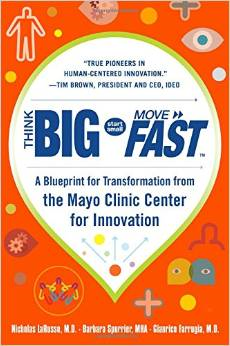Tis the season for blog entries, and this is the first of a mini-wave of three, all reflections on articles in the thought-provoking Winter '15 issue of the Stanford Social Innovation Review.
My topic here is the idea of innovation. What is innovation, and how does it happen? Gabriella Rosen Kellerman reviews a book called Think Big, Start Small, Move Fast, by LaRusso, Spurrier and Farrugia, all of the Mayo Clinic Center for Innovation. They make the case (I’m oversimplifying) that important innovations are usually practical and incremental rather than dramatic. The reviewer contrasts this with the popular theory that important innovations are “game-changers” that disrupt entire markets.
Our culture seems to love the idea that big innovations and charismatic innovators drive change. Many books and magazines feature the latest, greatest, hottest ideas, and the brilliant people that either hatched them or brought them to market. From a marketing standpoint I get this; a modest improvement such as a database that allows social workers to cut three tasks out of a 10-step process to enroll their clients in public benefits doesn’t sound very newsworthy if you’re trying to sell “news.” But it boosts worker productivity by 30%, saves tens of thousands of dollars for organizations strapped for cash, and improves the lives of their low-income clients. Boring but important.
By contrast, faddish innovations may make for good reading, but are often either highly exceptional, or may not even work. We usually don’t hear about last year’s featured brilliant idea that went nowhere. (Actually, disruptive innovation theory itself may be in this category.)
Most good ideas and most useful innovations are, in fact, incremental. Our media romanticizes the idea that individual superstars transform the world, but the exceptionality of these legends is usually at least part myth. I believe what we perceive as “innovation” is often very effective integration of ideas that were already out there. And all too often, people who become known as great innovators are in fact merely great at something else: self-promotion. (The nonprofit sector is no stranger to this concept, but I’ll avoid digressing.)
Jared Diamond nails these points in one of my favorite books, Guns, Germs and Steel. Diamond, by the way, is a great integrator who has a low-key demeanor quite the opposite of any known self-promoter. In looking at the development of human societies, he emphasizes the importance of several trends, two of which are the domestication of plants and animals. These true innovations happened long ago, took thousands of years to complete, and involved many incremental improvements and countless contributions of people whose names we’ll never know.
One of the most striking facts in the book is how very few domestications have happened in recorded history. Even with our alleged advanced technology, we have not been able to domesticate more than a few species—and taming the rabbit is not something we should brag about. We can’t even figure out how corn was domesticated; modern maize is so far from its ancestral wild plant that the vision and steps involved are mind-boggling. Our entire society could not exist without these innovations by generations of supposedly primitive people. The world we know is the product of systematic, continuous improvement, not huge jumps.
Diamond also debunks the myth of the “great man” (and in our sexist society, they usually have been men). Newton, Edison and even Einstein were integrators and incremental improvers of ideas that were in circulation. Same with Picasso, Curie, Ghandi, Freidan, Jobs and the Beatles, to diversify my examples. Sure, they were on one end of the human bell curve, but they weren’t working in isolation, and don’t deserve all the credit they often get. The unexciting fact is that we humans work together, are influenced by each other, and make change happen one step at a time.
This is how innovation happens in the nonprofit sector. We should recognize and celebrate small, non-headline improvements, and exercise caution in embracing big new ideas or people who claim to have “the answer.” The next generation comes from all of us.
My next entry is about a really sweet incremental innovation—a different way to think about long-term goals in nonprofits. Click here to read on...


